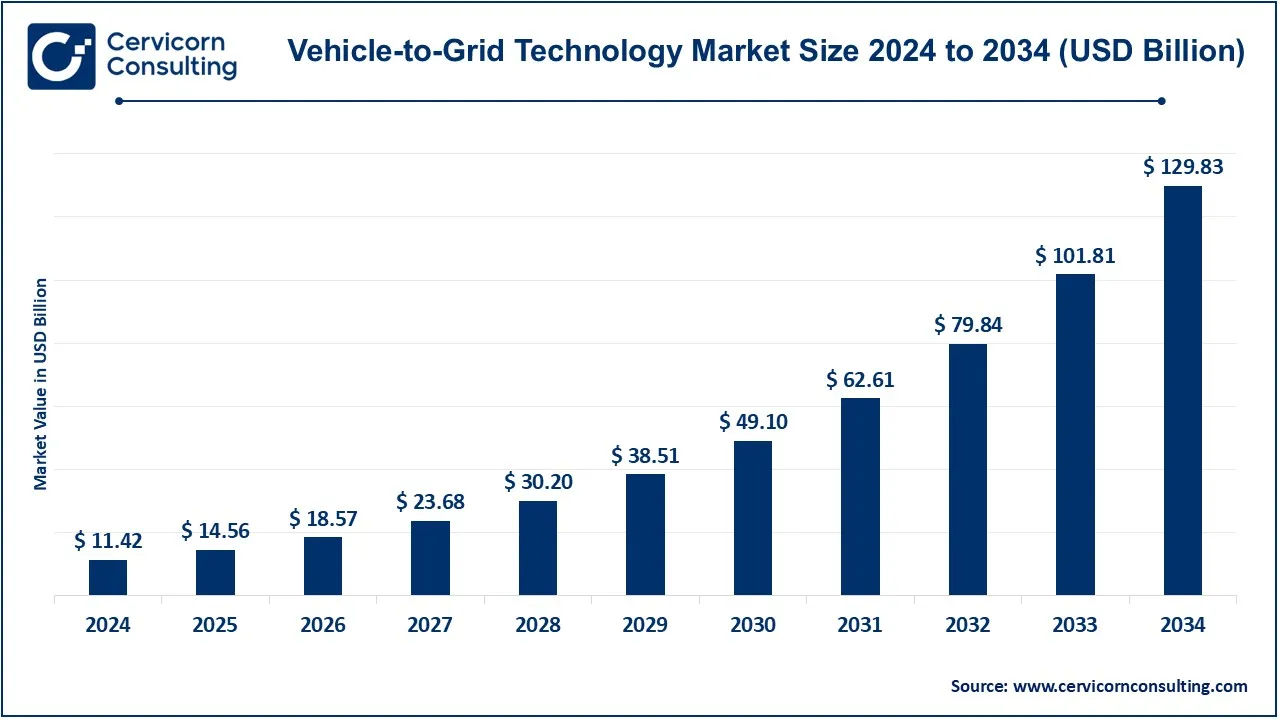Vehicle-to-Grid Technology Market Overview
The Vehicle-to-Grid (V2G) technology market is expanding at a remarkable pace, driven by the global transition toward electrification and renewable energy adoption. The market was worth USD 11.42 billion in 2024 and is projected to surge to around USD 129.83 billion by 2034, reflecting a robust CAGR of 27.51% from 2025 to 2034.
At its core, V2G technology enables two-way energy flow between electric vehicles (EVs) and the power grid. This allows EVs not only to draw power when charging but also to return excess electricity back to the grid. Such functionality strengthens grid stability, maximizes renewable energy use, and provides added economic benefits to EV owners, making it a vital component of the future energy framework.
📌 Get a Free Sample: https://www.cervicornconsulting.com/sample/2499
Key Market Trends
1. Integration of Renewable Energy with V2G Systems
-
The growing dependence on solar and wind power has increased the demand for balancing solutions.
-
V2G helps manage renewable intermittency by storing surplus energy in EV batteries and supplying it back during peak times.
-
Example: Enel SpA’s V2G initiatives in Denmark and Spain connect EV fleets with renewable plants to deliver cleaner and more reliable power.
2. Advances in Battery and Charging Technologies
-
Ongoing progress in lithium-ion and solid-state batteries is improving lifespan and performance, strengthening V2G potential.
-
Rapid bi-directional charging solutions, such as ABB’s Terra DC V2G chargers, are enabling faster and more efficient operations.
-
These advancements make V2G more practical for scaling up, especially for commercial fleets.
3. Government Incentives and Policy Support
-
Governments worldwide are offering grants, subsidies, and supportive regulations to accelerate EV adoption and V2G rollout.
-
The EU Green Deal prioritizes zero-emission mobility, while the U.S. Department of Energy is backing V2G pilot projects.
-
In Asia, Japan and China are spearheading Smart City initiatives that integrate V2G infrastructure.
4. AI- and IoT-Powered Smart Energy Management
-
AI and IoT platforms enable predictive demand analysis and real-time decision-making in V2G systems.
-
Cloud-based tools such as Nuvve’s GIVe™ platform enhance load balancing across EV fleets.
-
This boosts both grid efficiency and system reliability.
5. Collaborative Ecosystems Driving Innovation
-
Collaboration between automakers, energy providers, and tech companies is accelerating V2G adoption.
-
Example: Nissan and Ovo Energy’s Powerloop Project in the UK shows how partnerships can bring V2G into household energy systems.
Market Drivers
-
Surging Adoption of Electric Vehicles (EVs)
-
Global EV sales topped 14 million in 2023 (IEA).
-
The expanding EV fleet translates to vast distributed storage potential, functioning as virtual power plants (VPPs).
-
-
Growth of Renewable Energy
-
Renewables accounted for over 30% of global electricity generation in 2023.
-
V2G bridges the gap by managing fluctuations in renewable energy supply.
-
-
Policy Push and Climate Commitments
-
Countries targeting net-zero by 2050 are heavily investing in EV and V2G infrastructure.
-
Financial incentives such as tax credits and subsidies are driving adoption.
-
-
Rising Smart Grid Investments
-
The smart grid market is forecasted to surpass USD 130 billion by 2030.
-
V2G is central to smart grids, offering flexibility, distributed storage, and load management.
-
-
Economic Benefits for Stakeholders
-
EV owners can generate revenue by feeding power back into the grid.
-
Utilities reduce peak demand pressures and enhance resilience, making V2G mutually beneficial.
-
Impact of Trends and Drivers
-
By Segment:
-
Residential customers save on electricity costs with home-based V2G chargers.
-
Commercial fleets like buses and logistics vehicles provide grid support on a larger scale.
-
-
By Region:
-
Europe leads in adoption with strong regulatory frameworks and pilot projects.
-
Asia-Pacific shows rapid expansion thanks to China’s EV dominance and Japan’s Smart City programs.
-
North America, led by California, is pushing V2G as part of its renewable integration strategy.
-
Challenges & Opportunities
-
Challenges:
-
High initial infrastructure costs.
-
Concerns about battery degradation due to repeated cycling.
-
Lack of standardized protocols across markets.
-
-
Opportunities:
-
Adoption of solid-state batteries will ease performance concerns.
-
Fleet electrification in logistics and transport offers massive scaling potential.
-
Untapped emerging markets could benefit from decentralized grid stabilization through V2G.
-
Future Outlook
With rising EV penetration, smart grid development, and supportive regulatory environments, V2G is expected to transition from pilot projects into a mainstream energy solution.
Ultimately, this technology is poised to become a cornerstone of a carbon-neutral, resilient, and consumer-driven energy ecosystem.

